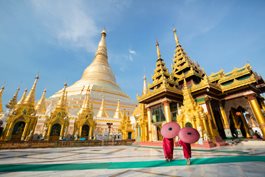Myanmar’s oldest shrine, the glittering gold Shwedagon Pagoda warrants at least two visits: one during the day, and one in the evening.

The Shwedagon Pagoda in Yangon is Myanmar’s most sacred Buddhist shrine. Somerset Maugham called it “…a sudden hope in the dark night of the soul.” The British, who tried at stages to loot, destroy, it, and occupy the pagoda, called it “the Crown of Burma.” For members of Myanmar’s independence movement, the glittering gold pagoda served as a symbol of national identity in the beginning of the twentieth century. No trip to Myanmar is complete without a visit — or rather several visits — to this ancient monument. Several visits, because it is equally important to see the pagoda at night, as it is to visit it during the day.
The Shwedagon pagoda was built more than 2,500 years ago to house eight strands of hair given by Siddhartha (who at the end of his journey to enlightenment became the Gautama Buddha) to two Burmese noblemen. The location atop the high Singuttara Hill was not random: the hill already housed relics from three of the previous reincarnations of Buddha, whom the faithful believe reappear in 5,000-year cycles.
The Shwedagon Pagoda is the nonpareil of Burmese architecture, possibly the oldest pagoda in the world, and, the faithful believe, is indestructible having survived numerous earthquakes that devastated the surrounding buildings. As a pilgrimage destination, it can be likened to Mecca or Kaaba, drawing hundreds of thousands of pilgrims each year in addition to the growing number of tourists to this emerging destination.
Rulers throughout the ages have enriched and enhanced the pagoda, which was gilded in gold in the fifteenth century by Queen Shinsawbu, who donated her own weight in gold to cover the surface, and her son Dhammazedi, who gifted four times his weight and that of his wife for the same purpose. Dhammazedi also ordered the largest bell in the world to be cast for the pagoda, weighing 300 tons. Stolen by the Portuguese, who planned to melt it down to make cannons, the bell fell off the raft on which it was being transported away from Yangon and sank to the bottom of the river, where it remains to this day.
The pagoda by day dazzles the eyes. Climbing to the highest platform through one of the four covered walkways provides a cool and quiet contrast to the riot of color and brilliant light that waits above, to say nothing of the hot tiles that have seared many pairs of bare feel of the faithful (today a carpet mercifully mitigates this experience). The stupa glitters with an unimaginable 7,000 jewels, including an enormous 76-carat diamond that crowns the top, positioned to capture and reflect the last rays of the sun as it sets.
As the sun sets, the pagoda gradually stops glittering and begins to glow and smolder against the darkling indigo sky. Linger to join pilgrims, monks, local people, and visitors in a quiet and timeless ritual of prayer and reflection as you light candles at the base of the pagoda.
Join Alexander + Roberts for a special visit to the Shwedagon Pagoda in the evening for the candle-lighting ceremony on our
Private Tour of Myanmar, an eight-day private tour with departures any day. Speak to our knowledgeable reservation agents about this, and other tours of Asia and beyond.